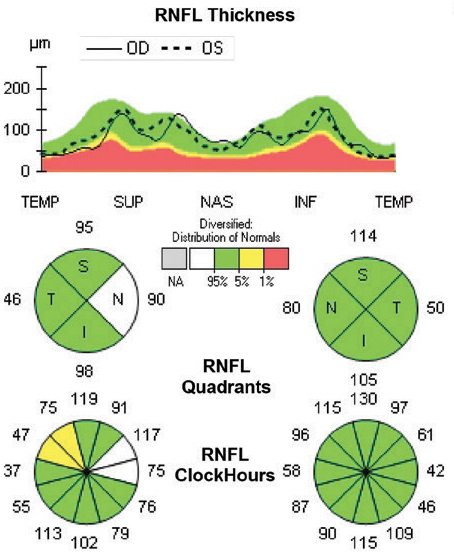 |
| RNFL thicknesses vary between people of different ethnicities, study shows. Photo: Ryan Schott, OD. Click image to enlarge. |
The current built-in normative databases of commercial OCTs are predominantly based on Caucasian data, and many clinicians worry that applying a Caucasian-dominant normative database on Asian eyes would potentially result in misclassification when detecting glaucoma. Therefore, comprehensive evaluation of Asian ethnic variations is needed for a more accurate detection of glaucomatous damage. Researchers based in Singapore analyzed data from over 22,000 non-glaucomatous eyes in multiple Asian population studies and found that Indian and Japanese eyes had thinner RNFL profiles compared with other Asian ethnicities. Also, systemic vascular factors, such as hypertension and cardiovascular disease, were observed to be significant determinants for RNFL thickness.
The study pooled 22,436 participants who were 40 years and older from 10 population-based studies (China, Hong Kong, India, Japan, Russia and Singapore) of the Asian Eye Epidemiology Consortium and evaluated ethnic variations and ocular and systemic determinants of RNFL thickness and neuroretinal rim area among Asians.
The researchers noted Indian and Japanese eyes had significantly thinner RNFL profiles compared with Chinese, Malay-Japanese, Tartar and Bashkir ethnicities. Indian eyes also showed smaller rim area compared with Chinese and Malays. Based on the pooled analysis, the estimated average rate of RNFL thinning was 2.70μm/decade and the decrease in rim area was 0.019mm2/decade.
The study also compared differences in RNFL thickness and rim area between different commercial SD-OCTs. The researchers found that the Cirrus HD-OCT (Zeiss) produced significantly thinner RNFL thickness and smaller rim area values when compared with Optovue, Nidek and Spectralis (Heidelberg). While the diameter of the scan circle was largely similar across all devices (3.45mm to 3.46mm), they suggest that the difference in reference plane adopted in each OCT machine might explain the observed difference in RNFL thickness.
“Collectively, our findings further suggest the need for a more ethnic-specific normative database for commercial SD-OCT machines to potentially improve detection of glaucoma in Asians,” the researchers concluded in their paper.
Majithia S, Tham YC, Chun Yuen CC, et al. Retinal nerve fiber layer thickness and rim area profiles in asians: pooled analysis from the Asian Eye Epidemiology Consortium. Ophthalmology. November 29, 2021. [Epub ahead of print]. |


